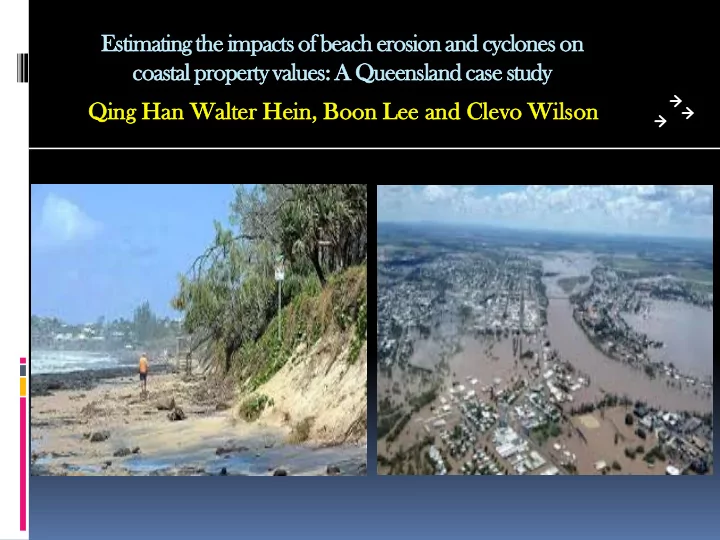

Estim imatin ing t the im impac acts o of be beac ach e erosion an and cyclones o on coastal l property v valu alues: A Que ueensla land c cas ase s study Qin ing g Han an W Walt alter Hein in, B Boon L Lee an and Cle levo W Wils ilson
Background to to the the stu study Beach erosion is common and natural disasters such as cyclones are becoming more frequent Can impact adversely on coastal infrastructure and private properties located along the coast In Australia many large cities lie along the coast More than 85% of Australia’s population is living within 50km from the coast Climate change and a rise in sea levels will increase beach erosion and severity of cyclones Will no doubt have an impact on industrial, road/rail and residential assets.
Ob Objec jectives o of the s e study To analyse the impacts of beach erosion and storms on property values in Sunshine Coast and Northern Queensland respectively To better understand some of coastal hazard risks To allow policymakers to make appropriate coastal planning in the future to mitigate and minimise coastal hazards damage To facilitate beach erosion and storm hazard planning in the future To raise public awareness and future potential buyers’ knowledge of coastal properties along the coastlines and northern Queensland Potentially diminish the problem of asymmetric information between buyers and sellers.
Study S Sites: B Beach E Eros rosion on Three suburbs from Sunshine coast were selected - Buddina, Alexandra Headland and Mooloolaba Selected based on the erosion prone maps published by the Sunshine Coast Council in 2012 All residential properties selected from these three suburbs in Sunshine Coast are located within 1.8 kilometres distance from the beach A total of 913 real estate sales transaction data from 2006 to 2012 were considered.
St Study Sit Sites: Beach h Eros rosion on Sunshine C Coast E Eros rosion on Pron rone A Are rea Mapping
es cyclones St Study Sit Sites: Cycl clones Four sites were selected from North Queensland:, Tully, Innisfail, Mission Beach and Cardwell Selection based on cyclones report published by the Australian Bureau of Meteorology - suburbs that were damaged most by Cyclone Yasi The suburbs were also affected by cyclone Larry in 2006 A total of 500 real estate sales transaction data from 2003 to 2012 were considered.
Study S Sites es: C Cycl clones es
Main Main q que uestions as asked in in this s study Do residents living in coastal suburbs value living further away from erosion prone beaches despite the desirability to live near the beach? Do coastal property values decrease sharply after a major cyclone has occurred? Furthermore, how soon do they recover?
Method odol ology Hypotheses were tested using a Hedonic Pricing valuation model The model includes a vector of structural, neighbourhood and environmental characteristics as explanatory variables OLS and spatial models Data used include Rpdata, ABS census data, google maps
Beac ach E Eros rosion on Analy alysis is: R Regre ression R Results The primary hypothesis was that residential property prices in the three suburbs would increase as the direct distance in metres to the beach increases However, the regression results show an opposite effect. For instance, for every one-unit increase in direct distance to beach, residential property value in Buddina would depreciate by 0.22% The results are statistically significant at 1% level across models
Inte terpr preta tati tion of r resu sults ts One explanation is that residents living in Buddina, Alexandra Headland and Mooloolaba discount the threat of beach erosion, which could potentially affect their properties In other words, the value of living close to beaches for recreational and aesthetic reasons far outweighs the threat of beach erosion in all the three suburbs.
Inte terpr preta tati tion o of resul ults It could also be that these three suburbs were declared as erosion prone by the Sunshine Coast Council only in 2012 (Department of Environment and Heritage Protection, 2013). Therefore, there was a lag for this announcement to take full effect and reach out to all residents living in these three suburbs As a result, residents in these suburbs did not take the risk of beach erosion into account. They only considered their present utility.
Inte terpr preta tati tion o of resul ults Another possible explanation for the negative relationship between distance to Beach and residential sales prices is the fact that residents living in these suburbs are well-aware of the mitigation policies that are undertaken by the Council As a result residents in these suburbs are able to discount the risk of beach erosion.
Cyclo lone A Analy alysis is: R Regre ression R Results The main research question in this study was to determine the impact of cyclones on Tully, Innisfail, Mission Beach and Cardwell’s residential property values This result show that Cyclone Yasi did have a significant negative impact on residential property values. Cyclone Yasi had a much larger impact on Mission Beach and Cardwell’s residential property values than Tully and Innisfail’s residential property values.
Cyclo lone Analy alysis is: R Regr gressio ion R Result ults Cyclone Larry had a smaller impact on property values than Cyclone Yasi This is to be expected since cyclone Yasi was much larger than cyclone Larry Furthermore, property prices recovered slowly after cyclone Larry but was once again affected by cyclone Yasi.
Potential contribution of this study Policy planning Coastal hazard mapping Insurance policy implications Increasing future potential buyers’ knowledge Population planning in coastal areas Council planning (who should pay, for example, beach erosion mitigation)
Recommend
More recommend